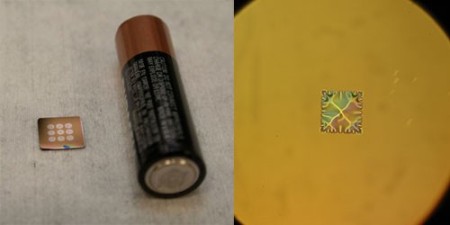A research team at the Harvard School of Engineering and Applied Sciences has developed a new solid-oxide fuel cell that can produce electricity by converting hydrogen and is also capable of storing electrochemical energy just as a battery. The fuel cell can generate power for a shorter period even after the fuel exhaust.

Left: Each dark speck within the nine white circles at left is a tiny fuel cell. An AA battery is shown for size comparison. (Photo by Caroline Perry, SEAS Communications.) Right: One of the nine circles is magnified in this image, showing the wrinkled surface of the electrochemical membrane. (Micrograph by Quentin Van Overmeere.)
Principal investigator, Shriram Ramanathan explained that the new thin-film solid-oxide fuel cell leverages the latest developments in low-temperature operation to integrate a new multipurpose material. The new solid-oxide fuel cell utilizes a platinum and vanadium oxide bilayer as the anode, which extends the cell’s operation even after fuel exhaustion. The extended period is 3 min and 30 s at 0.2 mA/cm2 current density, which is a 14-fold increase when compared to a platinum-anode SOFC that lasts 15 s when the fuel runs out.
Vanadium oxide used in the anode acts a multipurpose material that enables the cell to produce and store energy, said Ramanathan. During regular operation, the new device produces power comparable to that of a platinum-anode SOFC. In the mean time, the novel nanostructured vanadium oxide triggers different chemical reactions that sustain even after the hydrogen fuel is depleted.
Ramanathan explained that the vanadium oxide anode triggers three possible reactions, of which first is vanadium ion oxidation; second is hydrogen storage inside the vanadium oxide crystal lattice, which allows the steady release and oxidation of hydrogen at the anode; and third is the difference in oxygen ion concentration between the anode and cathode, which indicates the oxidation of oxygen anions as in a concentration cell. However, the mechanism which enables the fuel cell to continue its operation is not clear although all three mechanisms are capable of generating electrons. Hitherto, the researchers experimentally and quantitatively identified that at least two of them are working concurrently.
Ramanathan informed that the new cell is only in the proof-of-concept stage. The operating life of the cell can be extended further by improving the composition of the platinum-vanadium oxide anode. The new fuel cell will play key role in portable, small-scale energy applications. The researchers hope that a more advanced version of this fuel cell that runs for a longer time without fuel will be ready for applications testing in two years.
Disclaimer: The views expressed here are those of the author expressed in their private capacity and do not necessarily represent the views of AZoM.com Limited T/A AZoNetwork the owner and operator of this website. This disclaimer forms part of the Terms and conditions of use of this website.